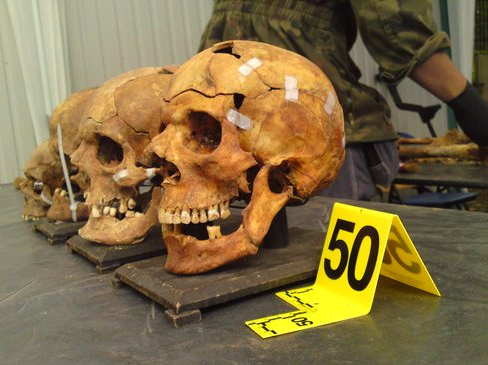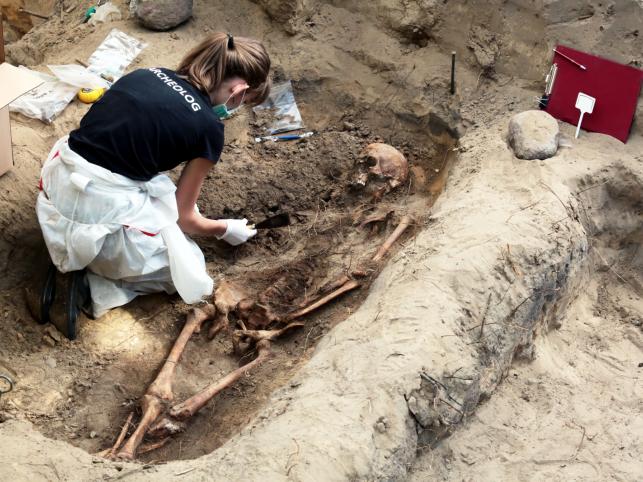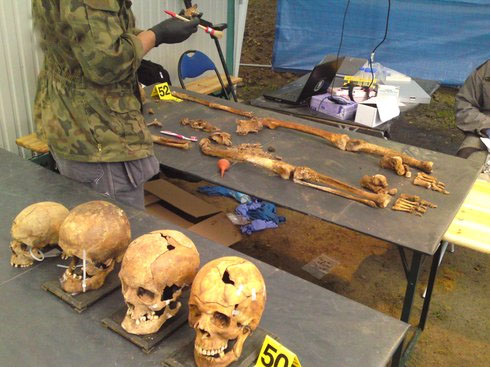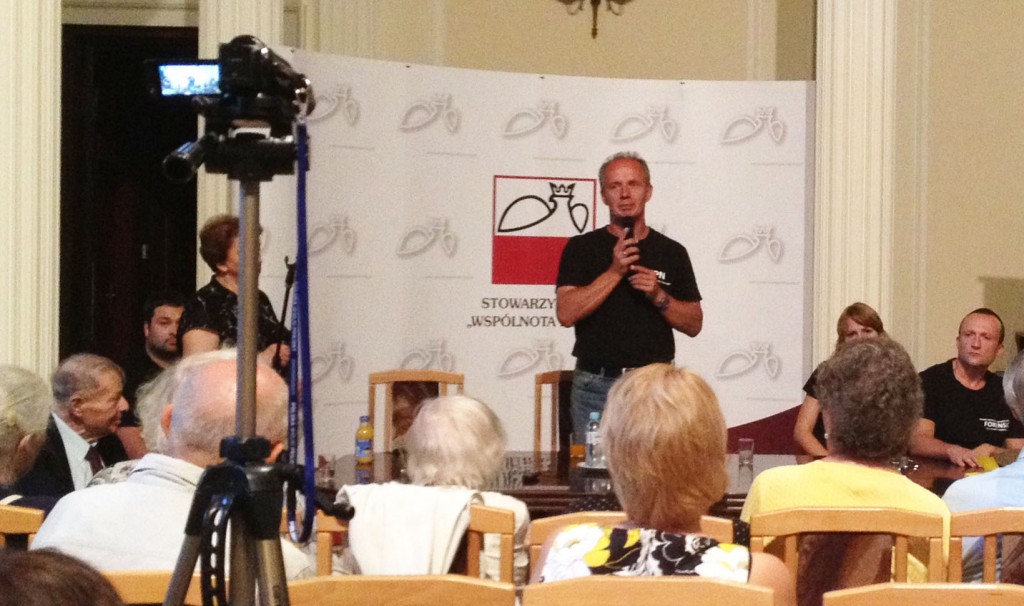Remains unearthed at the Powązki Cemetery in Warsaw, August, 2012
Today is the anniversary of the Soviet invasion of Poland on September 17, 1939. The Soviets cooperated with the Nazis to dismember Poland and enslave her people. As we now know, perhaps as many as 200,000 Poles living in the Soviet Union had already been murdered as part of an ethnic cleansing campaign, known as the Polish Operation of the NKVD, in 1937-1938. Nearly 22,000 Polish officers who had been captured by the Soviets in 1939, were executed by the NKVD in the spring of 1940, at Stalin’s orders. Hundreds of thousands of Poles were deported from eastern Poland, many thousands of whom died of starvation and exposure to the elements.
Once the Red Army re-entered Poland in 1944 as an “ally” of the Western Powers, the arrests and executions of Poles continued, particularly of those who were members of the Polish Underground State. The occupation of Poland by the Soviet Union and the establishment of a Communist puppet state began a new chapter of darkness and repression, the wounds of which have yet to heal.
Below is the English translation of the article “Medalik w czaszce” (Medallion in the Skull) from the Rzeczpospolita (The Republic) newspaper published on September 6, 2012. It consists of an interview with Dr. Krzysztof Szwagrzyk, an IPN (Instytut Pamięci Narodowej, Institute of National Remeberance) historian who is leading exhumation work at Warsaw’s Powązki Cemetery, to recover the remains of some of Poland’s greatest heroes. The interview was conducted by Piotr Zychowicz.
Begin Translation:
What happened after 1944 in Poland was the final part of the work of the German and Soviet occupiers. The Communists finished off the Polish elite – assert’s an IPN historian in a conversation with Piotr Zychowicz.
How did the people die, whose bodies you are recovering at Powązki Cemetery ?
Two-thirds of the victim’s have been shot through the skull by bullet. The entrance cavity is on the back or side of their head. They were shot at close range with a pistol.
The Katyń method.
Yes, the Katyń method, moved to Polish soil after 1944. Likewise, the Bolshevik attitude towards the bodies of the murdered. In the Soviet Union it wasn’t sufficient to put a person to death, it followed to obliterate any trace of their burial place. So that no one could ever find the bodies and identify those tortured to death. That’s how criminals operate. And that’s how Polish Communists operated.
Segregating recovered skulls
Some of the bodies were supposedly covered with calcium oxide (“quicklime”).
We still don’t have the final results of chemical tests. Yet, I can confirm that in two of the burial pits we did find traces of the effects of chemical agents which led to the advanced disintegration of human remains. The torso of these skeletons – from the legs up to the skulls – is practically non-existent. Since we’re talking about, among other things, spines and pelvises, bone tissue, which in general is well-preserved, we suppose that these bodies were deliberately doused with a chemical substance.
How many bodies were you able to recover?
We found the remains of 116 people. 109 have been removed. With the rest there’s a problem since we’ve only reached fragments of the body – heads, arms or legs – the rest is located under sidewalks and paths. In other words, beyond the territory in which we have permission to dig. These bodies will be dealt with in the second stage of work.
What problems have you run into during the exhumations?
Six months ago we finished work in the Osobowice Cemetery in Wrocław. We were able to recover and remove many bodies of victims of Communist crimes. It seemed to us that we’d be able to utilize that experience in Warsaw. However, even though it’s the same period of Communist terror, the scale of difficulty of work at the “Meadow” at Powązki was far greater.
Why?
In Wrocław the prisoners, who were murdered in the prisons and detention centers of the UB (Urząd Bezpieczeństwa, Department of Security), were written into the cemetery logbook. The field and grave number was noted. People were laid individually. In Warsaw there were three, four, six and even nine people in one burial pit. These pits were too small and people were piled up. Oftentimes, in order to fit the maximum number of bodies, the legs of one of the murdered victims were laid on the head of the next. People weren’t placed in graves, they were thrown in.
How do you know this?
This can be seen by the arrangement of the bodies. Legs, shoulders. Many people lay face down, or on their side. They were thrown down from a significant height. Straight from a horse-drawn wagon, and later from trucks. Often, feet and arms are still leaning on the side wall of the graves. It’s a dramatic sight. In between the bodies we found lumps of coal, which indicates that vehicles used to supply heating fuel transported the bodies. The most appalling thing though is whom they are laying with.
With whom?
The “Ł” quarter in the Powązki Cemetery, where we conducted surveys, was again designated for burials in the 1960s, 70s and 80s. It’s not a coincidence that the graves of many people engaged in the Communist terror were placed there. Ministry of Public Security personnel, military prosecutors, judges who handed down death sentences. After several decades, the criminals were buried next to their victims.
With whom specifically?
Julia Brystiger, chief of Department V of the MBP (Ministerstwo Bezpieczństwa Publicznego, Ministry of Public Security). Ilia Rubinow, the judge responsible for the murder of General Emil Fieldorf. Roman Kryże, a judge who had many death sentences on his account. One could spend a long time listing others.
You’re saying that this isn’t a coincidence.
No, because the practice of burying those honored by the Communist authorities in areas earlier used to hide the victims of the Red Terror was likewise applied in many other places in the PRL (Polska Rzeczpospolita Ludowa, People’s Republic of Poland). Communists believed that their system would be eternal. Thus they believed that no-one would ever dig-up the graves of well-known Communists. This way the traces of the crime would vanish forever.
One of 116 sets of remains unearthed at the “Meadow” in Powązki Cemetery
Whose bodies are you recovering?
Until we have the results of DNA tests, we can’t say with certainty who we’ve succeeded in recovering. We know that General Emil Fieldorf, Captain Witold Pilecki, Major Zygmunt Szendzielarz “Łupaszka”, Colonel Hieronim Dekutowski “Zapora”, Lieutenant Colonel Stanisław Kasznica, the last commandant of the National Armed Forces, were buried at the Meadow. The most beautiful figures in our history. Over 20 knights of the Virtuti Militari, over a dozen combatants in the Warsaw Uprising, Cichociemni (“The Unseen and Silent”). The flower of the nation. What happened after 1944 was the final part of the tragic work of the German and Soviet occupiers. The Communists finished off the Polish elite. Those whom the Soviets and Germans hadn’t managed to exterminate.
What did the road to the death pits on the Meadow look like?
The victims were brought by night. From the prison on Rakowiecka street and likewise from the Military Information prison and Department of Security prisons in the Praga district. Specially designated prisoners, escorted by prison guards, buried the bodies. The victims were those sentenced to die and also people tortured to death after their arrest. This is evidenced by the discovery of personal objects with their bodies, which in general are taken away from prisoners: glasses, belts.
How were the verdicts carried out?
After the proclamation of the death sentence people waited about 90 days for the execution in a multi-person cell. Up to 60 people stayed there. Soldiers from the Underground, felons, German criminals – everyone together. Prisoners sensed that they were going to die, so they tried to leave a sign for their families. Lieutenant Colonel Łukasz Ciepliński, chairman of the IV command of WiN (Wolność i Niezawisłość, Freedom and Independence), told his friends in the cell, if they survived, to tell his relatives that before his death he put a medallion of the Blessed Mother into his mouth. It left open the possibility of identifying his body after the years.
Did you find a medallion in one of the skulls?
We found five, six such medallions. Not only Ciepliński had this idea.
Arranging the remains of the victims
Let’s return to the death cells.
When that day arrived, several guards came to the condemned. They called the person “by the letter”. They led him to the place where the head of the prison, prosecutor and sometimes a priest were. The condemned learned that Bolesław Bierut hadn’t granted a pardon. He was led down a hallway and in a side basement where he suddenly received a pistol shot in the back of his skull.
Who pulled the trigger?
In Warsaw the function of executioner was carried out by Aleksander Drej and Piotr Śmietański, old communists, former soldiers of the GL (Gwardia Ludowa, People’s Guard) and AL (Armia Ludowa, People’s Army). Primitive natures.
Poland regained independence 23 years ago. Why is exhumation work at the Meadow only being carried out now?
Since for many years our country was ruled by a climate of extreme animus towards similar endeavors. Settling accounts with Communist crimes wasn’t allowed. To say nothing of arresting and judging the criminals. After all, in the 1990s, the chief military prosecutor, Stanisław Zarakowski, was still alive, as was judge Mieczysław Widaj, who had several dozen verdicts on his account. Several dozen others were still alive, at their head being Helena Wolińska, to whom justice could have been measured out. This didn’t happen because of opposition from influential circles. It even turned out that a “Person of Honor” was a former general of the SB (Służba Bezpieczeństwa Ministerstwa Spraw Wewnętrznych, Security Service of the Ministry of Internal Affairs) who’s place should have been in prison. And people who researched Communist crimes were called the “dazed”. Thus, please don’t be surprised that with this type of situation it wasn’t possible to carry out exhumations.
When did the climate begin to change?
The break through was in 1999 and the establishment of the IPN. It was then that we started the “Sentenced to Death” research program. We tried to count the those murdered. Much time passed though before we could begin exhumations. Now, the second stage of work on the “Meadow” is before us, next year we’ll be excavating in Służewiec, where the Communists also buried their victims. We’re positively surprised by the huge response of the local community. People are calling us from every part of the country and requesting that we also conduct searches there. All of Poland is sown with mass graves in which rest the victims of the Red Terror.
Dr. Szwagrzyk at the press conference in the Polonia House in Warsaw, announcing the results of the first stage of exhumations, August 20, 2012
Why are you leading this excavation?
Because I believe that this is my duty. The people whose bodies we’re recovering are the greatest heroes of the Republic, it’s impossible to think that the Polish nation wouldn’t make every possible effort to recover their bodies and give them a proper burial.
Krzysztof Szwagrzyk is the head of the Departmental Bureau of Public Education of IPN in Wrocław. An investigator of Communist crimes. Author. Among others, “Crimes in the Realm of Law”, “Lawyers in the Time of Lawlessness”. He directs the exhumations of victims of Communist crimes on the “Meadow” in Warsaw’s Powązki Cemetery.
Rzeczpospolita (The Republic)
Recommended Reading:
–Franklin D. Roosevelt and the Coverup of the Katyń Massacre





3 thoughts on “The Medallion in the Skull”